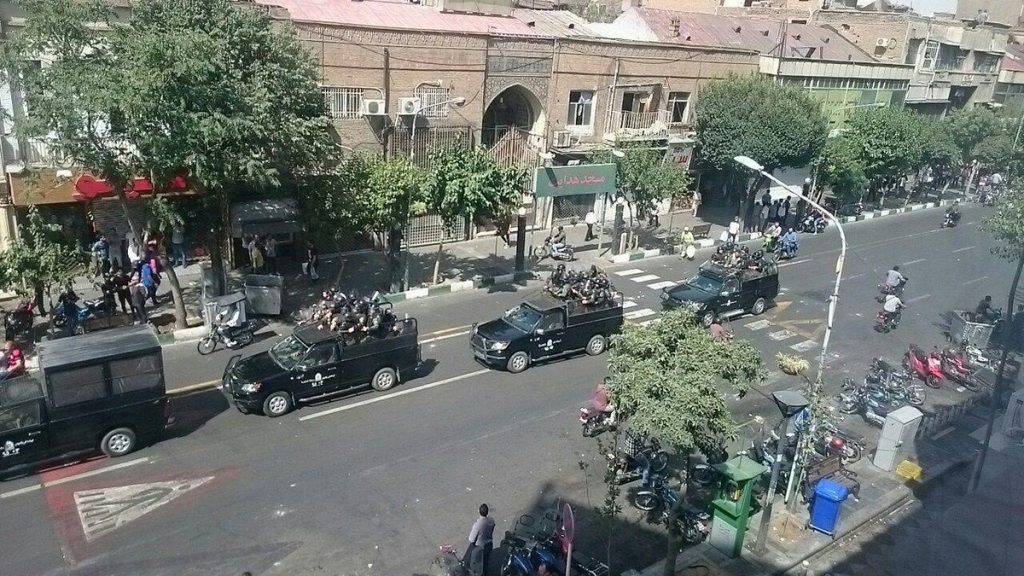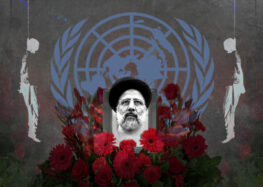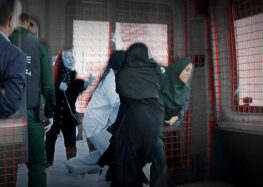Iran’s Judiciary Chief Threatens Protesting Merchants With Execution as Protests Continue

Tehran Demonstrations Against Inflation Turn Political as They Spread to Other Cities
The Chief Justice of Iran Sadegh Larijani has threatened the merchants who have been protesting in Tehran against the declining value of the rial since June 25, 2018, with execution if they don’t back down. Tehran Prosecutor Abbas Jafari Dowlatabadi has also blamed the protests on the US, adding that “a number of the main instigators” have been arrested.
“I’m warning you. Listen well. Take the cotton out of your ears and open your eyes. These actions against the country’s economic order are punishable by execution—if found to be on the level of ‘corruption on earth”—or up to 20 years in prison and the confiscation of all possessions,” said Larijani in a speech to judicial officials in Tehran on June 26.
“We will not hesitate to implement the law,” he added.
A business owner in Tehran’s Grand Bazaar told Center for Human Rights in Iran (CHRI) on June 26 that shutting down his business was not only a sign of “protest against the government’s economic policy but also a good business decision.”
“We are better off shutting down our stores for a month and coming back with much less loss, rather than selling goods and doing business,” said the merchant, referring to the substantial financial losses he would incur if he purchased goods at the current currency rate.
The protests by the merchants, known as bazaaris in Iran, began in Tehran’s Grand Bazaar on June 25, 2018, and turned into a mass socioeconomic and political rally outside the Parliament building where police fired tear gas at crowds chanting anti-state slogans.
The demonstrations started after another sharp fall in the value of the Iranian currency, the rial, which in a matter of weeks has lost nearly half its value in the black market. Iranian banks issue a limited amount of dollars, forcing people to obtain currencies on the black market, which trades at a much higher rate.
The official rate set by the Central Bank of Iran is currently about 42,500 rials to the dollar, but the rate on the street was closer to 100,000 rials as of June 25.
The bazaar was closed on June 25 but smaller protests continued the next day in Tehran and around the country including the cities of Isfahan, Arak and Kermanshah on June 26.
Building on Larijani’s threats, the Tehran prosecutor refused to address the protesters’ complaints, which have been simmering for years in Iran against the country’s domestic and foreign policies, particularly since December 2017/January 2018, and instead accused the demonstrators of “rioting” as part of an alleged American plot against Iran.
“My message to those who are disrupting security and the economy is that the judicial system will firmly deal with any kind of rioting and disturbance and the perpetrators will be put on trial like those who caused riots last December and February,” he told reporters on June 26. “The judiciary chief has said that disrupting the economy and security will carry heavy punishments.”
“I inform these individuals and their families that they will not be released until they are prosecuted,” added Dowlatabadi. “Those who are trying to disrupt the Islamic state are not bazaari types. You will see that the bazaaris will distance themselves. The people will not allow a few individuals to give themselves the right to cause turbulence in the bazaar and create economic insecurity.”
He continued: “This is a serious plot devised by the Americans to spread insecurity in Iran. Yesterday they tried to intimidate bazaaris to close their shops and start riots in some parts of the city and damage some places of business.”
Other Iranian officials recognized that the protesters’ concerns were rooted in rising inflation and the high rate of inflation.
“The price of goods is constantly on the rise and merchants can’t restock items they have already sold,” Ahmad Karimi Isfahani, chairman of the Islamic Society of Merchants, told the state-funded Iranian Labor News Agency (ILNA) on June 25. “The instability has left customers and merchants unsatisfied.”
“For 40 years we have not seen this kind of action that would shut down the bazaar, but today it happened and we believe that the only and only reason is mismanagement inside the country,” he added.
After closing their shops in Tehran’s main bazaar on June 25, the merchants marched from surrounding streets toward Baharestan Sq. in front of the Parliament building chanting “death to the dictator,” “death to expensiveness,” “death to freeloading thugs,” “Iranians! Enough is enough, show your mettle” and “our misery is because of Syria, Palestine… Let go of Syria; think about our situation.”
“I don’t think economic problems are the only factor for the people’s dissatisfaction,” said Abdolreza Hashemizaie, a reformist Member of Iran’s Parliament (MP), in an interview with ILNA on June 25.
“In fact, people are grappling with political and social concerns and if the authorities don’t do anything about them, these economically rooted civil protests will turn into disturbances,” he added.
Another reformist MP, Jahanbakhsh Mohebbinia told ILNA on June 25, “Up to now, the people have given the officials opportunities to solve economic problems. I suggest officials do not blame the people’s movement on foreign instigations.”
*This story was updated on June 26, 2018, to reflect the comments by Tehran Prosecutor Abbas Jafari Dowlatabadi.






